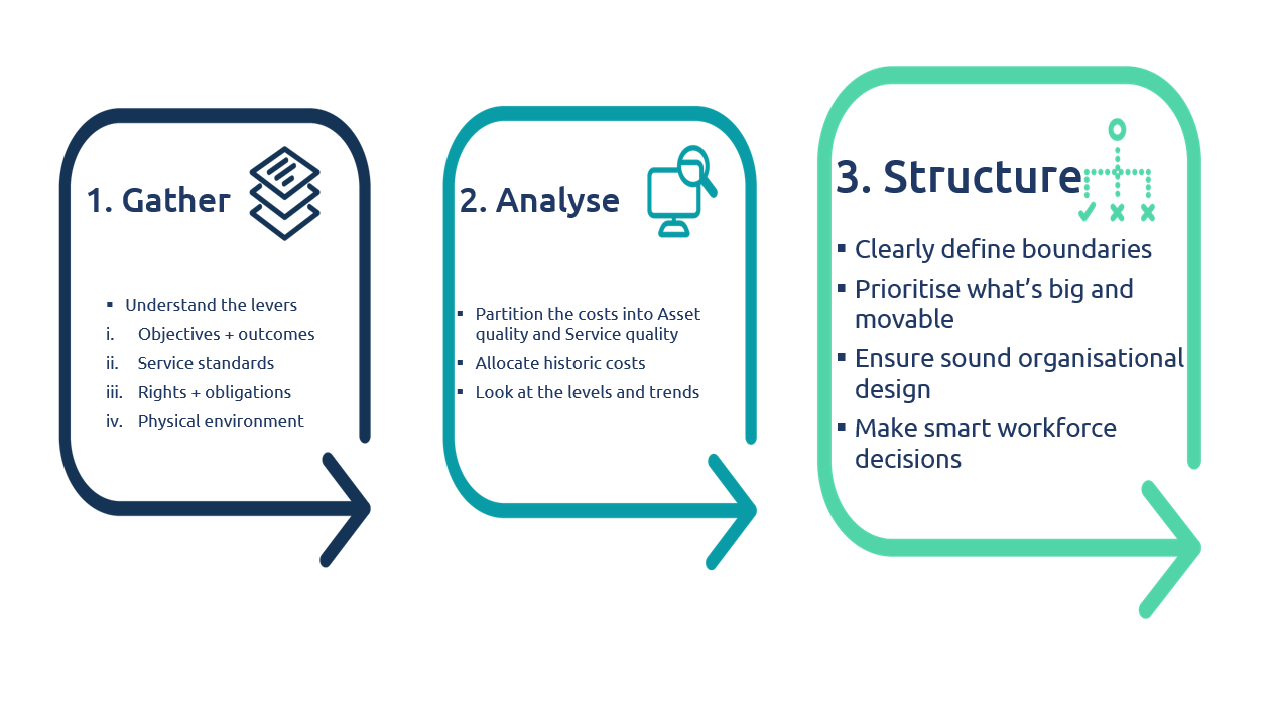
The third step to create value and reduce your total cost of occupancy
So, you’ve followed the first two steps and gathered and analysed your data, the third step is to reassemble your findings into a structure that creates value and reduces occupancy costs in your workplace.
Structure
Your structure is a workplan that helps you understand the boundaries of the opportunity, get your organisational design right, and ensure that work flows quickly to the person best able to manage it.
Clearly define boundaries
All good problem solving requires good problem definition. The shape of the Corporate Real Estate, Facilities, and Workplace opportunity was ‘pegged out’ in the Analyse step as Asset quality costs and Service quality costs. When structuring your workplan you should carefully add further subcategories to clearly define the extent and boundaries of your work.
For example, in our Gross Rent category, we carefully define the Asset Class then include the subcategories that comprise Gross Rent – Net Rent, Statutory outgoings, Variable outgoings etcetera. Note that you should continue the subcategories until they are exhausted. For example, listing each component (and sub-component) of Variable outgoings. This is important. Tracking only Gross Rent can lead to errors in budgeting and worse – paying more than you should.
Clearly defined the boundaries for Asset quality costs and Service quality costs enables you to measure the direct contribution of Corporate Real Estate, Facilities, and Workplace to organisational values and provides the parameters to measure the return on investment from the spaces you occupy.
Prioritise what’s big and moveable
So, you’ve found the levers, partitioned your costs, and understood the impacts. Next, quickly identify the elements that you can and cannot change. Then, prioritise the levers that are big and moveable, and understand when, and by how much, you can move them.
Typically, the big levers are rent, term, makegood, redecorate, energy, cleaning, HVAC, Mech/Elect/Fire, repairs and maintenance, CRE, FM and Workplace salaries, insurances, and waste removal.
As we mentioned in the beginning of our discussion, rent, term, makegood, and redecorate events may only occur once every five or ten years. But they are significant levers and essential to the health of your occupancy. You must ensure you know your critical dates and that you are ready to act – sometimes two years ahead of an event.
Ensure sound organisational design
To optimise your total cost of occupancy, work should flow quickly to the subject matter expert best able to manage it. The source of the expertise can be insourced, out-tasked, or outsourced. But it must be based on knowledge, capability, capacity, desire, resources, and investments in technology.
The right organisational design ensures role clarity, increases levels of accountability, leverages investments in technology, and eliminates cost duplication.
Make smart workforce decisions
Create clearly defined and measurable outcomes for each role in your Corporate Real Estate, Facilities, and Workplace portfolio, then carefully allocate workloads (and create a RACI) to ensure you don’t have $120,000 resources doing $60,000 work.
If you would like to receive all five steps, please send me DM with the message “Five steps”. Otherwise, in my next post, we will look at Implementation.
#workplace, #outsourcing, #collaboration, #corporaterealestate, #facilitiesmanagement
Let us know what you think about this insights article
